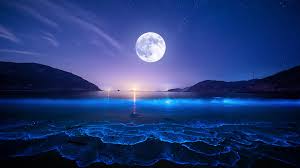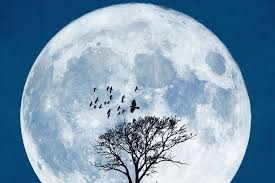The Moon: Earth’s Celestial Companion
Its presence in the night sky has inspired countless myths, scientific inquiries, and even dreams of space exploration. The Moon is not just a distant celestial object but a close and intimate neighbor of Earth, influencing various aspects of our planet and playing a significant role in human history and culture.
Table of Contents
Formation and Characteristics

The Moon: is believed to have formed about 4.5 billion years ago, shortly after the Earth itself. According to this theory, a Mars-sized body, often referred to as Theia, collided with the early Earth.
The Moon is roughly one-quarter the diameter of Earth, with a diameter of about 3,474 kilometers (2,159 miles). Its mass is about 1/81 of Earth’s, and its gravity is approximately 1/6th that of our planet. The Moon has a very thin atmosphere, known as an exosphere, which is composed of hydrogen, helium, neon, and other trace gases. This lack of a substantial atmosphere means that the Moon’s surface experiences extreme temperature variations, ranging from about -173°C (-280°F) at night to 127°C (260°F) during the day.
Phases and Orbit

The Moon: orbit around Earth is elliptical, with an average distance of about 384,400 kilometers (238,855 miles). It takes approximately 27.3 days to complete one orbit around Earth, which is also the time it takes for the to rotate once on its axis. This synchronous rotation means that the same side of the often called the “near side,” always faces Earth, while the “far side” remains largely unseen from our planet.
The Moon: phases are a result of its orbit around Earth and the changing angles of sunlight that strike its surface. As the orbits Earth, different portions of its surface are illuminated by the Sun, leading to the familiar cycle of phases: new , crescent, first quarter, gibbous, and full. This cycle repeats every 29.5 days, a period known as a synodic month.
Influence on Earth

The Moon: exerts a significant influence on Earth, most notably through its gravitational pull, which is responsible for the tides. The gravitational attraction between Earth and the causes the oceans to bulge out in the direction of the , creating high tides. As the Earth rotates, these bulges move, resulting in the rise and fall of sea levels. The tidal forces also affect Earth’s rotation, gradually slowing it down over time. This phenomenon, known as tidal braking, has led to a gradual increase in the length of Earth’s day.
The Moon: gravitational pull also stabilizes Earth’s axial tilt, which is crucial for maintaining a relatively stable climate. Without the Earth’s axis could tilt more drastically, leading to extreme changes in climate and potentially making the planet less hospitable for life.
Exploration
The Moon: has been the focus of human fascination and exploration for centuries. Early observations were made with the naked eye, and later with telescopes, re
However, it was not until the mid-20th century that humanity took its first steps toward physically exploring the .
The space race between the United States and the Soviet Union during
the Cold War era culminated in a series of missions aimed at landing humans . The Soviet Union achieved the first significant milestone with the launch of Luna 2 in 1959,
which became the first spacecraft to reach the . In 1961, President John F. Kennedy set a bold goal for the United States:
to land a man on the and return him safely to Earth before the end of the decade.
The Moon: in Culture and Mythology
The Moon: has held a significant place in human culture and mythology across different civilizations. In many ancient cultures, the was associated with gods and goddesses. For example, in Greek mythology, Selene was the goddess of the ,
while in Roman mythology, the goddess Luna was her counterpart. The ancient Egyptians associated the with the god Thoth, who was believed to be the god of wisdom and writing.
In literature and art, the has been a source of inspiration, often symbolizing mystery, romance, and the subconscious. From Shakespeare’s plays to modern poetry, the has been a recurring motif that captures the imagination and emotions of people.
Scientific Discoveries and Future Exploration
The exploration of the has led to significant scientific discoveries that have deepened our understanding of both the Earth. Analysis of lunar rocks brought back by the Apollo missions revealed the Moon’s geological history,
including evidence of volcanic activity and impacts from asteroids and comets. These studies also provided insights into the early solar system and the processes that shaped the terrestrial planets.
NASA’s Artemis program aims to return humans to the by the mid-2020s,
with the goal of establishing a sustainable lunar presence by the end of the decade. Artemis will include crewed missions, robotic landers, and
the construction of the Lunar Gateway,
a space station orbiting the that will serve as a hub for exploration and scientific research.
indianfastearning.comThe moon has an atmosphere. Scientists solve 50-year-old mystery Scientists solve 50-year-old mystery 2024
Conclusion
The Moon: with its enduring presence in the night sky, continues to be a source of wonder and exploration. Its influence on Earth, its role in shaping human culture,
and its potential as a stepping stone to further space exploration make it one of the most fascinating objects in our solar system. As humanity prepares to return to the Moon and explore its mysteries, the Moon remains a symbol of our curiosity, our achievements, and our aspirations for the future.
www.youtube.comhttp://The Moon:







